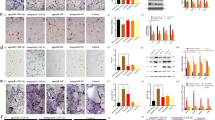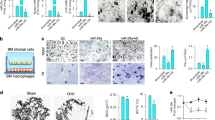Abstract
Emerging evidence indicates that microRNAs (miRNAs) have important roles in regulating osteogenic differentiation and bone formation. Thus far, no study has established the pathophysiological role for miRNAs identified in human osteoporotic bone specimens. Here we found that elevated miR-214 levels correlated with a lower degree of bone formation in bone specimens from aged patients with fractures. We also found that osteoblast-specific manipulation of miR-214 levels by miR-214 antagomir treatment in miR-214 transgenic, ovariectomized, or hindlimb-unloaded mice revealed an inhibitory role of miR-214 in regulating bone formation. Further, in vitro osteoblast activity and matrix mineralization were promoted by antagomir-214 and decreased by agomir-214, and miR-214 directly targeted ATF4 to inhibit osteoblast activity. These data suggest that miR-214 has a crucial role in suppressing bone formation and that miR-214 inhibition in osteoblasts may be a potential anabolic strategy for ameliorating osteoporosis.
This is a preview of subscription content, access via your institution
Access options
Subscribe to this journal
Receive 12 print issues and online access
$209.00 per year
only $17.42 per issue
Buy this article
- Purchase on Springer Link
- Instant access to full article PDF
Prices may be subject to local taxes which are calculated during checkout






Similar content being viewed by others
References
Marx, J. Coming to grips with bone loss. Science 305, 1420–1422 (2004).
Karsenty, G. The complexities of skeletal biology. Nature 423, 316–318 (2003).
Alliston, T. & Derynck, R. Medicine: interfering with bone remodelling. Nature 416, 686–687 (2002).
Rodan, G.A. & Martin, T.J. Therapeutic approaches to bone diseases. Science 289, 1508–1514 (2000).
Tromans, A. Physiology: foreman in the bone factory. Nature 425, 909 (2003).
Harada, S. & Rodan, G.A. Control of osteoblast function and regulation of bone mass. Nature 423, 349–355 (2003).
Boyle, W.J., Simonet, W.S. & Lacey, D.L. Osteoclast differentiation and activation. Nature 423, 337–342 (2003).
Rigoutsos, I. & Furnari, F. Gene-expression forum: decoy for microRNAs. Nature 465, 1016–1017 (2010).
Chitwood, D.H. & Timmermans, M.C. Small RNAs are on the move. Nature 467, 415–419 (2010).
Ambros, V. The functions of animal microRNAs. Nature 431, 350–355 (2004).
Kosik, K.S. MicroRNAs and cellular phenotypy. Cell 143, 21–26 (2010).
Zhang, J. et al. Effects of miR-335–5p in modulating osteogenic differentiation by specifically downregulating Wnt antagonist DKK1. J. Bone Miner. Res. 26, 1953–1963 (2011).
Eskildsen, T. et al. MicroRNA-138 regulates osteogenic differentiation of human stromal (mesenchymal) stem cells in vivo. Proc. Natl. Acad. Sci. USA 108, 6139–6144 (2011).
Itoh, T., Nozawa, Y. & Akao, Y. MicroRNA-141 and -200a are involved in bone morphogenetic protein-2–induced mouse pre-osteoblast differentiation by targeting distal-less homeobox 5. J. Biol. Chem. 284, 19272–19279 (2009).
Huang, J., Zhao, L., Xing, L. & Chen, D. MicroRNA-204 regulates Runx2 protein expression and mesenchymal progenitor cell differentiation. Stem Cells 28, 357–364 (2010).
Itoh, T., Takeda, S. & Akao, Y. MicroRNA-208 modulates BMP-2–stimulated mouse preosteoblast differentiation by directly targeting V-ets erythroblastosis virus E26 oncogene homolog 1. J. Biol. Chem. 285, 27745–27752 (2010).
Inose, H. et al. A microRNA regulatory mechanism of osteoblast differentiation. Proc. Natl. Acad. Sci. USA 106, 20794–20799 (2009).
Li, Z. et al. A microRNA signature for a BMP2-induced osteoblast lineage commitment program. Proc. Natl. Acad. Sci. USA 105, 13906–13911 (2008).
Kapinas, K., Kessler, C., Ricks, T., Gronowicz, G. & Delany, A.M. miR-29 modulates Wnt signaling in human osteoblasts through a positive feedback loop. J. Biol. Chem. 285, 25221–25231 (2010).
Hassan, M.Q. et al. A network connecting Runx2, SATB2, and the miR-23a∼27a∼24–2 cluster regulates the osteoblast differentiation program. Proc. Natl. Acad. Sci. USA 107, 19879–19884 (2010).
Li, H. et al. A novel microRNA targeting HDAC5 regulates osteoblast differentiation in mice and contributes to primary osteoporosis in humans. J. Clin. Invest. 119, 3666–3677 (2009).
Hu, R. et al. A Runx2/miR-3960/miR-2861 regulatory feedback loop during mouse osteoblast differentiation. J. Biol. Chem. 286, 12328–12339 (2011).
Mizoguchi, F. et al. Osteoclast-specific Dicer gene deficiency suppresses osteoclastic bone resorption. J. Cell. Biochem. 109, 866–875 (2010).
Gaur, T. et al. Dicer inactivation in osteoprogenitor cells compromises fetal survival and bone formation, while excision in differentiated osteoblasts increases bone mass in the adult mouse. Dev. Biol. 340, 10–21 (2010).
Yang, X. et al. ATF4 is a substrate of RSK2 and an essential regulator of osteoblast biology; implication for Coffin-Lowry Syndrome. Cell 117, 387–398 (2004).
Kobayashi, T. et al. Dicer-dependent pathways regulate chondrocyte proliferation and differentiation. Proc. Natl. Acad. Sci. USA 105, 1949–1954 (2008).
Zhang, G. et al. A delivery system targeting bone formation surfaces to facilitate RNAi-based anabolic therapy. Nat. Med. 18, 307–314 (2012).
Sachdeva, M. & Mo, Y.Y. MicroRNA-145 suppresses cell invasion and metastasis by directly targeting mucin 1. Cancer Res. 70, 378–387 (2010).
Li, Z. et al. Biological functions of miR-29b contribute to positive regulation of osteoblast differentiation. J. Biol. Chem. 284, 15676–15684 (2009).
Penna, E. et al. microRNA-214 contributes to melanoma tumour progression through suppression of TFAP2C. EMBO J. 30, 1990–2007 (2011).
Ueda, T. et al. Relation between microRNA expression and progression and prognosis of gastric cancer: a microRNA expression analysis. Lancet Oncol. 11, 136–146 (2010).
Yin, G. et al. TWISTing stemness, inflammation and proliferation of epithelial ovarian cancer cells through MIR199A2/214. Oncogene 29, 3545–3553 (2010).
Yang, H. et al. MicroRNA expression profiling in human ovarian cancer: miR-214 induces cell survival and cisplatin resistance by targeting PTEN. Cancer Res. 68, 425–433 (2008).
Dey, S. et al. Both transcriptional regulation and translational control of ATF4 are central to the integrated stress response. J. Biol. Chem. 285, 33165–33174 (2010).
Yamaguchi, S. et al. ATF4-mediated induction of 4E–BP1 contributes to pancreatic β cell survival under endoplasmic reticulum stress. Cell Metab. 7, 269–276 (2008).
Black, D.M. et al. One year of alendronate after one year of parathyroid hormone (1–84) for osteoporosis. N. Engl. J. Med. 353, 555–565 (2005).
Finkelstein, J.S. et al. The effects of parathyroid hormone, alendronate, or both in men with osteoporosis. N. Engl. J. Med. 349, 1216–1226 (2003).
Fuller, K.E. Effects of parathyroid hormone and alendronate alone or in combination in osteoporosis. N. Engl. J. Med. 350, 189–192, author reply 189–192 (2004).
Black, D.M. et al. The effects of parathyroid hormone and alendronate alone or in combination in postmenopausal osteoporosis. N. Engl. J. Med. 349, 1207–1215 (2003).
Cosman, F. et al. Daily and cyclic parathyroid hormone in women receiving alendronate. N. Engl. J. Med. 353, 566–575 (2005).
Miller, P.D. Effects of parathyroid hormone and alendronate alone or in combination in osteoporosis. N. Engl. J. Med. 350, 189–192, author reply 189–192 (2004).
Guo, B.S., Cheung, K.K., Yeung, S.S., Zhang, B.T. & Yeung, E.W. Electrical stimulation influences satellite cell proliferation and apoptosis in unloading-induced muscle atrophy in mice. PLoS ONE 7, e30348 (2012).
Zhang, B.T. et al. The effects of low frequency electrical stimulation on satellite cell activity in rat skeletal muscle during hindlimb suspension. BMC Cell Biol. 11, 87 (2010).
Dierkes, C. et al. Catabolic properties of microdissected human endosteal bone lining cells. Calcif. Tissue Int. 84, 146–155 (2009).
Kase, M., Houtani, T., Sakuma, S., Tsutsumi, T. & Sugimoto, T. Laser microdissection combined with immunohistochemistry on serial thin tissue sections: a method allowing efficient mRNA analysis. Histochem. Cell Biol. 127, 215–219 (2007).
Amin, S. et al. High serum IGFBP-2 is predictive of increased bone turnover in aging men and women. J. Bone Miner. Res. 22, 799–807 (2007).
Addison, W.N., Azari, F., Sorensen, E.S., Kaartinen, M.T. & McKee, M.D. Pyrophosphate inhibits mineralization of osteoblast cultures by binding to mineral, up-regulating osteopontin, and inhibiting alkaline phosphatase activity. J. Biol. Chem. 282, 15872–15883 (2007).
Vermes, C. et al. Particulate wear debris activates protein tyrosine kinases and nuclear factor kappaB, which down-regulates type I collagen synthesis in human osteoblasts. J. Bone Miner. Res. 15, 1756–1765 (2000).
Juan, A.H., Kumar, R.M., Marx, J.G., Young, R.A. & Sartorelli, V. Mir-214–dependent regulation of the polycomb protein Ezh2 in skeletal muscle and embryonic stem cells. Mol. Cell 36, 61–74 (2009).
Iwaniec, U.T. et al. PTH stimulates bone formation in mice deficient in Lrp5. J. Bone Miner. Res. 22, 394–402 (2007).
Acknowledgements
We thank the academic staff (L. Qin and L. Hung) from the Chinese University of Hong Kong and the research staff from G.Z.'s lab (http://www.gezhanglab.com/index.php) at Hong Kong Baptist University for providing critical comments and technical support. We thank X. Yang (Institute of Biotechnology) for providing the Bglap2 promoter vector. We also thank L. Zhang, K. Guan and H. Ouyang for constructive suggestions and careful revisions to this manuscript. This work was supported by the National Basic Research Program of China 973 program (2011CB711003 and 2011CB707704), State Key Lab of Space Medicine Fundamentals and Application Grants (SMFA10A02 and SMFA12B01), National Natural Science Foundation Projects (31170811, 31000386 and 81272045), the Hong Kong General Research Fund (HKBU 479111 and HKBU478312) and the Research Grants Council/Natural Science Foundation Council Joint Research Scheme (N_HKBU435/12).
Author information
Authors and Affiliations
Contributions
X.W. and B.G. performed the majority of the experiments, analyzed data and prepared the manuscript. J.P., A.W., X.P., X.X. and A.H. collected human bone samples. Z.Y. and H.W. helped with in vivo treatment. Q.L., K.L., J.S., Q.S., S.L., Yuheng Li and P.Z. assisted with in vitro experiments. G.K., H.C. and M.Z. maintained the mice. Z.H. helped with microdissection analysis. D.L. and T.T. helped with data analysis. Yinghui Li, Z.B., Y.B., A.L. and F.H. provided suggestions for the project and critically reviewed the manuscript. Yingxian Li and G.Z. supervised the project and wrote most of the manuscript.
Corresponding authors
Ethics declarations
Competing interests
The authors declare no competing financial interests.
Supplementary information
Supplementary Text and Figures
Supplementary Figures 1–7 and Supplementary Table 1 (PDF 1701 kb)
Rights and permissions
About this article
Cite this article
Wang, X., Guo, B., Li, Q. et al. miR-214 targets ATF4 to inhibit bone formation. Nat Med 19, 93–100 (2013). https://doi.org/10.1038/nm.3026
Received:
Accepted:
Published:
Issue Date:
DOI: https://doi.org/10.1038/nm.3026
This article is cited by
-
LncRNA LINC00205 stimulates osteoporosis and contributes to spinal fracture through the regulation of the miR-26b-5p/KMT2C axis
BMC Musculoskeletal Disorders (2023)
-
Icariin promotes the proliferation and osteogenic differentiation of bone-derived mesenchymal stem cells in patients with osteoporosis and T2DM by upregulating GLI-1
Journal of Orthopaedic Surgery and Research (2023)
-
Targeting strategies for bone diseases: signaling pathways and clinical studies
Signal Transduction and Targeted Therapy (2023)
-
Ferroptosis contributes to ethanol-induced hepatic cell death via labile iron accumulation and GPx4 inactivation
Cell Death Discovery (2023)
-
Annexin A5 derived from matrix vesicles protects against osteoporotic bone loss via mineralization
Bone Research (2023)



